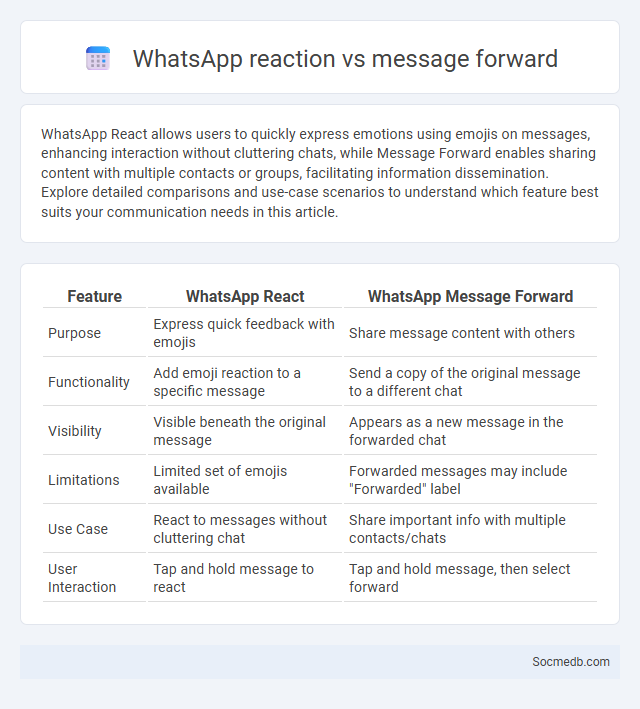
Photo illustration: WhatsApp react vs message forward
WhatsApp React allows users to quickly express emotions using emojis on messages, enhancing interaction without cluttering chats, while Message Forward enables sharing content with multiple contacts or groups, facilitating information dissemination. Explore detailed comparisons and use-case scenarios to understand which feature best suits your communication needs in this article.
Table of Comparison
| Feature | WhatsApp React | WhatsApp Message Forward |
|---|---|---|
| Purpose | Express quick feedback with emojis | Share message content with others |
| Functionality | Add emoji reaction to a specific message | Send a copy of the original message to a different chat |
| Visibility | Visible beneath the original message | Appears as a new message in the forwarded chat |
| Limitations | Limited set of emojis available | Forwarded messages may include "Forwarded" label |
| Use Case | React to messages without cluttering chat | Share important info with multiple contacts/chats |
| User Interaction | Tap and hold message to react | Tap and hold message, then select forward |
Overview of WhatsApp Reactions and Message Forwarding
WhatsApp Reactions enable users to quickly express emotions on messages using emojis, enhancing communication without sending additional texts. This feature supports six initial reactions: thumbs up, heart, laughing face, surprised face, crying face, and folded hands, fostering instant feedback within chats. Message forwarding on WhatsApp allows users to share content across individual or group conversations, with forwarded messages labeled to promote transparency and reduce misinformation spread.
Key Differences: React vs Message Forward
React on social media platforms enables users to quickly express emotions or feedback through emojis, offering immediate and concise interaction. Message Forward allows users to share content from one conversation to another, facilitating information distribution and broader reach within networks. Unlike React, which captures sentiment, Message Forward emphasizes content propagation and user engagement across different chat threads or groups.
How to Use WhatsApp Reaction Feature
WhatsApp's reaction feature allows you to quickly respond to messages with emojis, enhancing communication without typing a full reply. To use it, tap and hold the message you want to react to, then select from the available emoji options like thumbs up, heart, or laughing face. This feature helps streamline conversations, making your interactions more expressive and efficient on WhatsApp.
Forwarding Messages: Step-by-Step Guide
Forwarding messages on social media platforms involves selecting the desired message, tapping the forward or share icon, and choosing one or multiple recipients from your contacts or groups. Most apps provide options to add personal comments or modify the message before sending. Maintaining privacy settings and confirming the recipient's consent helps ensure responsible and secure message forwarding.
Benefits of Reacting to Messages
Reacting to messages on social media enhances real-time communication by providing immediate feedback without disrupting conversation flow. Emoticons and reaction icons convey emotions quickly, increasing engagement and fostering stronger connections among users. This feature also streamlines interactions, making it easier to acknowledge messages efficiently in group chats and busy online communities.
Privacy Considerations: Reactions vs Forwards
Social media privacy considerations highlight that reactions such as likes or emojis typically reveal minimal personal information, whereas forwards or shares can exponentially increase content exposure, potentially compromising user data. Reactions often remain within a user's network, limiting privacy risks, while forwards can spread content to broader, uncontrolled audiences. Understanding these differences is crucial for managing digital footprints and safeguarding personal information on platforms like Facebook, Instagram, and Twitter.
Group Chats: Reactions vs Message Forwarding
Group chats on social media enhance communication by allowing users to share reactions instantly, offering a more nuanced and emotional response than simple text replies. Message forwarding facilitates the quick spread of information but can lead to misunderstandings or loss of context, affecting group dynamics and trust. Your effective use of reactions promotes clearer, more engaging interactions, while mindful message forwarding helps maintain privacy and message integrity.
Limitations of WhatsApp Reactions and Forwards
WhatsApp reactions are limited to a predefined set of emojis, restricting users from expressing nuanced emotions or customized feedback. Forwards are capped to a maximum of five chats at once, a measure aimed at curbing misinformation but potentially hindering rapid information sharing. These restrictions impact user interaction, emphasizing simplicity and control over versatility and breadth of communication.
Best Practices for Using React and Forward
Using React and forwardRef effectively enhances social media app performance by enabling seamless component reusability and direct DOM manipulation for UI consistency. You should prioritize memoization techniques, such as React.memo and useCallback, to prevent unnecessary re-renders and improve load times across social platforms. Leveraging forwardRef allows your components to maintain optimal responsiveness and accessibility by passing refs down the component tree efficiently.
Future Updates: WhatsApp React and Message Forward Features
WhatsApp's upcoming React feature will enhance your messaging experience by allowing quick, expressive responses without typing, streamlining conversations with emojis and interactive elements. The improved Message Forward functionality aims to curb misinformation by limiting the number of forwards and adding context to shared messages, ensuring safer communication. These updates reflect WhatsApp's commitment to privacy, user engagement, and fostering meaningful digital interactions.
 socmedb.com
socmedb.com